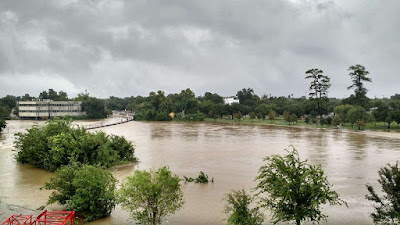With rains to continue soaking
Texas for days to come, flooding to spread to neighboring states, and a
tropical system off the Atlantic coast, there are two words that one does not
heard being said by Republicans: climate change. Climate scientists have long said that the
severity of tropical storm systems will intensify - Harvey was a category 4
with literally unprecedented rainfall - and as a piece in Politico points out,
we are seeing a worldwide phenomenon of worsening rainstorms. Locally, the Virginian Pilot reports this:
The
system was moving northeast at 12 mph early this morning and had winds of
approximately 40 mph. As the storm moves faster to the northeast, the hurricane
center expects it to become extra-tropical and gain strength, with winds
increasing to 60 to 80 p.m. – causing nor'easter-like conditions to
Hampton Roads this evening. Winds could gust to 60 mph.
Compared to Harvey, this is nothing. But we must not forget that last October, Hurricane Matthew caused unprecedented flooding in portions of
Hampton Roads. Areas of Virginia Beach
and Chesapeake which had never flooded in memory saw 2-3 feet of water, in many
cases inundating homes. Pretending that climate change is not happening and refusing to rethink development patterns and infrastructure needs is not a responsible solution. Here are highlights from Politico:
In all of U.S. history, there’s never been a storm like Hurricane Harvey. That fact is increasingly clear, even though the rains are still falling and the water levels in Houston are still rising.But there’s an uncomfortable point that, so far, everyone is skating around: We knew this would happen, decades ago. We knew this would happen, and we didn’t care. Now is the time to say it as loudly as possible: Harvey is what climate change looks like. More specifically, Harvey is what climate change looks like in a world that has decided, over and over, that it doesn’t want to take climate change seriously.
Houston has been sprawling out into the swamp for decades, largely unplanned and unzoned. Now, all that pavement has transformed the bayous into surging torrents and shunted Harvey’s floodwaters towards homes and businesses. Individually, each of these subdivisions or strip malls might have seemed like a good idea at the time, but in aggregate, they’ve converted the metro area into a flood factory. Houston, as it was before Harvey, will never be the same again.
Harvey is the third 500-year flood to hit the Houston area in the past three years, but Harvey is in a class by itself. By the time the storm leaves the region on Wednesday, an estimated 40 to 60 inches of rain will fall on parts of Houston. So much rain has fallen already that the National Weather Service had to add additional colors to its maps to account for the extreme totals.
Harvey is now the benchmark disaster of record in the United States. As with Katrina, Harvey gives us an opportunity for an inflection point as a society. The people of Houston didn’t choose this to happen to them, but what happens next is critically important for all of us.
Climate change is making rainstorms everywhere worse, but particularly on the Gulf Coast. Since the 1950s, Houston has seen a 167 percent increase in the frequency of the most intense downpours. . . . While Harvey’s rains are unique in U.S. history, heavy rainstorms are increasing in frequency and intensity worldwide. One recent study showed that by mid-century, up to 450 million people worldwide will be exposed to a doubling of flood frequency. This isn’t just a Houston problem. This is happening all over. A warmer atmosphere enhances evaporation rates and increases the carrying capacity of rainstorms. Harvey drew its energy from a warmer-than-usual Gulf of Mexico, which will only grow warmer in the decades to come. At its peak, on Saturday night, Harvey produced rainfall rates exceeding six inches per hour in Houston, and its multi-day rainfall total is close to the theoretical maximum expected for anywhere in the United States. By continuing to pretend that we can engineer our way out of the worsening flooding problem with bigger dams, more levees and higher-powered pumping equipment, we’re fooling ourselves into a more dangerous future.
It’s possible to imagine something else: a hopeful future that diverges from climate dystopia and embraces the scenario in which our culture inevitably shifts toward building cities that work with the storms that are coming, instead of Sisyphean efforts to hold them back. That will require abandoning buildings and concepts we currently hold dear, but we’ll be rewarded with a safer, richer, more enduring world in the end. There were many people in Houston already working on making that world a reality even before Harvey came.
If we don’t talk about the climate context of Harvey, we won’t be able to prevent future disasters and get to work on that better future. Those of us who know this need to say it loudly. As long as our leaders, in words, and the rest of us, in actions, are OK with incremental solutions to a civilization-defining, global-scale problem, we will continue to stumble toward future catastrophes. Climate change requires us to rethink old systems that we’ve assumed will last forever.
The symbolism of the worst flooding disaster in U.S. history hitting the sprawled-out capital city of America’s oil industry is likely not lost on many. Institutionalized climate denial in our political system and climate denial by inaction by the rest of us have real consequences. They look like Houston.
Once Harvey’s floodwaters recede, the process will begin to imagine a New Houston, and that city will inevitably endure future mega-rainstorms as the world warms. The rebuilding process provides an opportunity to chart a new path. The choice isn’t between left and right, or denier and believer. The choice is between success and failure.

No comments:
Post a Comment